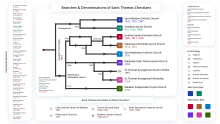Christianity in Kerala


History
This section needs additional citations for verification. (July 2020) |
The tradition of origin among Saint Thomas Christians relates to the arrival of Thomas, one of the 12 disciples of Jesus, at the ancient seaport Muziris on the Kerala coast in AD 52.[5][6][2][7][8]
It is also possible for
The earliest known source connecting the apostle to India is the Acts of Thomas, likely written in the early 3rd century, perhaps in Edessa. The text describes Thomas' efforts in bringing Christianity to Northwest India, specifically in the Indo-Parthian Kingdom.[9]
According to traditional accounts such as the "Thomma Parvam" ("Song of Thomas"), he is generally described as arriving in or around
Religious education
Denominations
Denominations among all Christians in Kerala
The 2011
The Saint Thomas Christians (Nasrani) of Kerala primarily belong to churches which use the
In 2016, 61% of Christians in the state were
Major Pentecostal denominations in Kerala include the
See also
- Caste system among South Asian Christians
- Goan Catholics
- East Indian Catholics
- Mangalorean Catholics
References
- ^ a b "Census of India". Retrieved 2009-04-12.
- ^ ISBN 978-0-8028-2417-2.
- ^ "Christianity in India". Members.tripod.com. Retrieved 2013-12-16.
- ^ Compiled by Robert Eric Frykenberg (2005-07-01). "Timeline". Ctlibrary.com. Archived from the original on 2013-10-18. Retrieved 2013-12-16.
- ^ "The Surprisingly Early History of Christianity in India".
- ^ "Thomas the Apostole". stthoma.com. Archived from the original on 8 February 2011. Retrieved 11 January 2022.
- ISBN 978-1-4008-7258-9, retrieved 2020-11-04
- ISSN 0240-8910.
- ^ Cordier, Henri (1920). Marco Polo; notes and addenda to Sir Henry Yule's edition, containing the results of recent research and discovery.
St. Ephraem the Syrian (born about A.D. 300, died about 378), who spent most of his life at Edessa, in Mesopotamia, states that the Apostle was martyred in ' India,' and that his relics were taken thence to Edessa. That St. Thomas evangelized the Parthians, is stated by Origen (born A.D. 185 or 186, died about 251-254). Eusebius (bishop of Caesarea Palaestinae from A.D. 315 to about 340) says the same
- ^ Eusebius, Book V Chapter 10 "Pantaenus the Philosopher"; Frykenberg (2008), p. 103; Baum & Winkler (2003), p. 52; Medlycott (1912); Whitehouse (1873), pp. 12–20.
- ^ "Indian Christianity".
- ISBN 978-1-108-01295-9. Retrieved 3 November 2012.
- ^ Walker (2011).
- ^ Frykenberg (2008), pp. 105, 110.
- ^ Frykenberg (2008), p. 112.
- ISBN 1-84212-409-9.
- ISBN 9780521548854.
- ^ Devika, J.; Varghese, V. J. (March 2010). To Survive or to flourish? Minority rights and Syrian Christian assertions in 20th century Travancore (PDF). Trivandrum: Centre for Development Studies. Archived from the original (PDF) on 26 May 2012. Retrieved 27 April 2012.
- ISSN 0971-751X. Retrieved 18 June 2022.
.. The first convent was a simple bamboo-mat house at Koonammavu, on the land once administered by Vareed Vakayil. The congregation, under Mother Eliswa, was given the task of teaching girls who had no means to pursue education. St. Joseph's LP School at Koonammavu was set up in 1868 as the first Catholic school for girls in Malabar. Mother Eliswa's mission in life was to educate young girls and she set up several girls' schools here. ..
- ISBN 978-90-04-36101-0.
- ISBN 978-1-870345-43-9.
- ISBN 978-0-8028-2734-0.
- ISBN 978-1-317-81866-3.
The Syrian Orthodox also became the target of Anglican missionary activity, as a result of which the Mar Thoma Church separated from the Orthodox in 1874, adopting the Anglican confession of faith and a reformed Syrian liturgy conforming to Protestant principles.
- ISBN 978-1-5246-7652-0.
Metropolitan Juhanon Mar Thoma called it "a Protestant Church in an oriental grab."...As a reformed Oriental Church, it agrees with the reformed doctrines of the Western Churches. Therefore, there is much in common in faith and doctrine between the MTC and the reformed Churches of the West. As the Church now sees it, just as the Anglican Church is a Western Reformed Church, the MTC is an Eastern Reformed Church. At the same time as it continues in the apostolic episcopal tradition and ancient oriental practices, it has much in common with the Oriental Orthodox Churches. Thus, it is regarded as a "bridging Church".
- ^ "Religious denominations of Kerala" (PDF). Archived from the original (PDF) on 2018-04-17. Retrieved 2021-05-08.
Works cited
- ISBN 9781134430192.
- Eusebius. Knight, Kevin (ed.). Church History. Translated by McGiffert, Arthur Cushman.. Book V Chapter 10.
- Frykenberg, Robert E. (2008). Christianity in India: From Beginnings to the Present. Oxford: Oxford University Press. ISBN 9780198263777.
- Medlycott, A (1912). "St. Thomas Christians". The Catholic Encyclopedia. New York: Robert Appleton Company. Retrieved 4 July 2021.
- Walker, Joel T. (2011). "Fars". In Sebastian P. Brock; Aaron M. Butts; George A. Kiraz; Lucas Van Rompay (eds.). Gorgias Encyclopedic Dictionary of the Syriac Heritage: Electronic Edition. Gorgias Press. Retrieved 22 September 2016.
- Whitehouse, Thomas (1873). Lingerings of light in a dark land: Researches into the Syrian church of Malabar. William Brown and Co.
Further reading
- George K.M.,`Christianity in India Through the Centuries`,Authentic Books, Secunderabad,2007,2009.(ISBN 978-81-7362-786-6).
- Benedict Vadakkekara,`Origin of Christianity in India`,Media House, Delhi,2007.ISBN 81-7495-258-6.
- Agur C.M.,`Church History of Travancore`,Madras,1903 Reprint:Asian Educational Services, New Delhi,1990. (ISBN 81-206-0594-2).
- Visvanathan Susan,`The Christians of Kerala`,Oxford University Press, Delhi1993,1999.(ISBN 0195647998)
- George Menachery,`The St. Thomas Christian Encyclopaedia of India`,SARAS,Ed.Prof. George Menachery, Ollur,Vol.I 1982, Vol.II 1973, Vol. III 2009.
- George Menachery,`Indian Church History Classics`,SARAS,Ed.Prof. George Menachery, Ollur,Vol.I The Nazranies 1998.
- C. I. Issac, The Evolution of Christian Church in India, ISBN 978 81 7255 056 12014, Soorygatha Publishers, PB No 3517, Kochi 682 035
